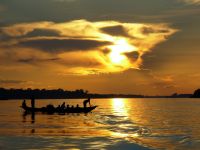Michael Deibert
KINSHASA, Apr 24 2008 (IPS) – The rain falls in battering sheets, rolling eastward along the Congo River through Kinshasa, capital of the Democratic Republic of Congo (DRC). It is midday, but the sky turns black and soon the potholed streets of this decrepit yet vibrant metropolis are filled with pond-sized puddles, many of them larger than the cars that traverse them.

The DRC's Congo River – one of many water sources in the Central African nation. Credit: Hugo Rami/IRIN
April is the beginning of the rainy season for the DRC #39s eastern provinces, a time when perpetually more water gets dumped on an already drenched region.
But despite an abundant rain supply and churning rivers, access to clean water has been a persistent problem for this Central African nation. As large as Western Europe, the DRC is still attempting to pick up the pieces after a decade of war and attendant upheaval that claimed the lives of over five million people, according to recent figures from the International Rescue Committee (IRC) relief organisation.
The dictator Mobutu Sese Seko, in power for over 30 years until 1997, likewise did little to develop the country #39s infrastructure.
A United Nations demographic and health survey conducted in the DRC in 2001 (the most recent year for which such data is available) concluded that only 46 percent of the national population had access to clean water. In rural areas, though natural water springs could be accessed by 60 percent of the population, just 30 percent of those springs were protected from potential contamination.
Kinshasa, a city of nearly eight million people, has no central sewerage system. In rural areas such as the provinces of North Kivu and Orientale, it is common to see women and children gathering water from a communal pump and then carrying it home in buckets.
Related IPS Articles
Despite ongoing clashes in the east of the country, a study published earlier this year asserted that less than one percent of all deaths in the DRC were directly attributable to violence. The majority of deaths have been due to infectious diseases, malnutrition and neonatal- and pregnancy-related conditions, stated the report, #39Mortality in the Democratic Republic of Congo: An ongoing crisis #39, produced by the IRC and the Burnet Institute a medical research and public health organisation based in Melbourne.
All too often, the infectious diseases in question take hold because water supplies are contaminated.
Mainly the causes (of diseases in the DRC) are water quality, whether or not the water has to be boiled, the hygiene is not clean around the house, and such, says Steven Lauwerier, deputy representative in the DRC for the United Nations Children #39s Fund (UNICEF).
Of the eight Millennium Development Goals adopted by the United Nations General Assembly in 2000, it is widely conceded that the DRC will be able to meet only one by the 2015 deadline, that of ensuring environmental sustainability, which includes, as a major component, sustainable access to safe drinking water.
To this end, in collaboration with the government of President Joseph Kabila, UNICEF has begun implementing a system called the Village Assaini, or Healthy Village programme, which seeks to promote not only the provision of clean water, but also hygienic and sanitary practices.
If you promote only clean water and people are not washing their hands properly, it #39s not going to reduce diarrhoea, so we thought that it was important to make a comprehensive package of different components, explains Rinko Kinoshita, a planning officer with UNICEF in the DRC.
A demand-based programme, Village Assaini requires that a community asks to participate in it, after which the government, foreign agencies and the community seek to reach goals such as providing 80 percent of households with proper toilets, and 70 percent with access to clean water. Materials not available locally, such as cement, will be supplied but community participation in the maintenance and protection of water sources with local materials is also key.
In another initiative, a non-governmental organisation headquartered in Washington that operates in the DRC, Population Service International (PSI), has focused on making available two types of water treatment tablets, for which recipients pay a nominal fee.
The first, a product called PUR, can significantly reduce the risk of diarrhoeal disease by removing dirt and intestinal worms from water. The other tablets, Aquatabs, reduce the risk of waterborne diseases such as cholera and typhoid.
They lower the cost for clear water and are much easier to transport than chlorine, says Theresa Gruber-Tapsoba, the country representative for PSI.
A single bag of Aquatabs is able to purify 20 litres of water, while the same amount of PUR is effective for 70 litres of water.
Chlorination is often used in the water treatment regimens of countries with more developed infrastructure as it is highly effective at killing waterborne bacteria.